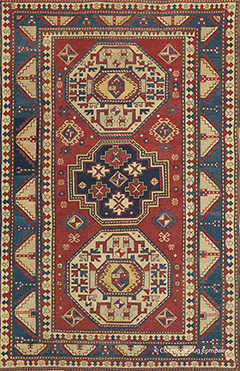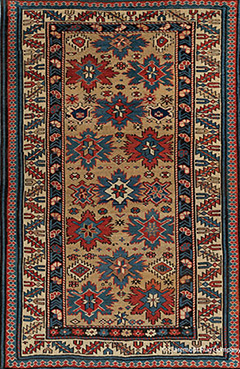|
The Impact of Color in Caucasian Rugs (Part 2)
OAKLAND, CA. - In the first article of this three-part series about antique Caucasian rugs woven during the Second Golden Age of Persian Weaving (ca. 1800 to ca. 1900), I examined the people, environment, and cosmology of the tribal weaving groups that wove these magnificent representations of the people (primarily women) who created them.
In this segment, I will discuss a core underpinning of the art of Caucasian rugs: an innate recognition of the impact of color. Their weavers knew which hues worked harmoniously together and how they could be “pushed” to resonate with each other, something the French Impressionist painters discovered later at work on their canvases and 1970’s scientists encountered in their labs. Experience taught the weavers that outlining sections with grey, blue, or red amplified dimensionality and that, given the eye’s propensity to blend colors, the “right” adjacent colors created the illusion of a greater range of hues than were there. All of which amplified the visual and emotional impact of their designs. In the 1930s, the Bauhaus movement cited Oriental rugs as central to their color interaction theory. I am vividly reminded of a stunning Caucasian Daghestan (ca. 1850) with a large dimension and one-in-the-world design reminiscent of hexagonal tile flooring. It featured a hooked “Wheel of Life” design in each tile. It presents the Caucasian weavers’ great dexterity in combining magnificent displays of vegetable-dyed colors in a seemingly random fashion. Such are the impressions left in my mind by a great Caucasian piece that they remain with me long after they have been placed with a client. That the weavers achieved this is particularly extraordinary when you consider that, unlike Van Gogh, the Impressionists or Bauhaus artisans, who had access to the finest available paints and comfortable studios, the weavers, often working on portable ground looms in a mountain meadow, relied exclusively on natural dyes they created from the plants in their immediate environment. Like all art forms, a limited number of 19th-century Caucasian rugs are spellbinding, while others are delightful. To live with a rug woven by a maestro is to continually discover new things—shifting motifs, playful variations on themes. An inexactitude that remains grounded by hidden natural laws of balance and harmony. An asymmetry that’s vitalizing rather than unsettling. Simultaneously diverse and whimsical, subtle, and bold, they surprise and reward us, over time, for our attention. And here’s the key to their 21st-century appeal: that their fascinating richness of pattern and color draws our attention, compelling us to slow down. The rugs show us that a sense of wonder is as valuable as ‘knowing.’ They reflect a life experience we have no access to, something we get a glimpse of when we spend extended time in nature. They invite contemplation and, in so doing, encourage us to do things thoroughly. They nurture us both intellectually and emotionally. Such magnetism was diluted and eventually lost as weaving morphed from a profound tribal art form to the “programmed” factory workshops of the early 20th century and beyond. Simply put, the ancient Caucasian weavers believed that process was as important as the product, that each step—from raising the sheep, spinning the yarn, and creating the dyes, to finally weaving the rug should be done to completion. Quality was never compromised for quantity, a value system increasingly absent today. This is above and beyond the rugs’ considerable decorative appeal and value as collectibles and rare tangible assets. By encouraging contemplation and reflecting the universal harmony in nature, these folkloric weavings provide negative ions, those elusive, electrically charged, mood-elevating, anti-depressant molecules most likely to be found in proximity to waterfalls, thunderstorms, and exuberant plant life. Over a half-century ago, when I first met impassioned collectors, the engagement with Caucasian rugs was already strong, and their following continues to grow today and as long as premier examples can be found, they will continue to speak to some of our deepest emotions and our sense of wonder. In the final installment of this series, I will examine specific symbols and their meanings.
|

